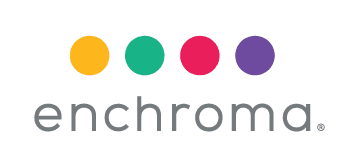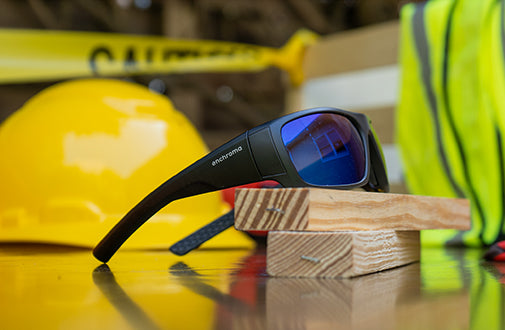Improving Efficiency and Accessibility at Work
with Color Blind Glasses
Did you know that one in 12 men (8%) and one in 200 women are color blind? Red green color blindness -- a broad term for the two most common types of color blindness, deuteranopia and protanopia-- affects the lives and work of tens of millions of people. While people with normal color vision see over one million hues and shades, the red green color blind only see about 10% of colors.
If you suffer from some type of color deficiency, you know how difficult it can be to perform some daily tasks, from deciphering seemingly muddled information from a color-confusing graph to distinguishing between red and green stoplights at an intersection. A recent San Francisco Chronicle article describes the experiences of several color deficient workers.
What do color blind people see? The chart above contrasts normal color vision with the color deficient view.
Red Green Colorblind at Work
According to a recent workplace accessibility survey of 810 color deficient respondents by EnChroma, 9 of 10 people with color vision deficiency (CVD) stated that identifying colors correctly plays a role in their job. Seventy-five percent reported that being red green color blind slows them down at work. Two-thirds have trouble interpreting color-coded materials and over 20% can’t perform certain work that requires accurate color-identification.
“I work in the nuclear power industry where color has many important roles, from safety signage and red/green indicator lights to being able to differentiate between colored wires, and I’ve always had to have someone check my work,” said Zachary Rowland, a color blind maintenance supervisor for a nuclear power plant and National Guardsman.
What do color blind people see?
The Solution? Color Blind Glasses
The survey, conducted by EnChroma, which invented the first scientifically proven-effective color blind glasses, reports that, despite the obstacles faced on a daily basis by tens of millions of color blind workers in a vast number of fields, 80% believe EnChroma glasses for color blindness could help them do their jobs better. Moreover, Human Resources, Safety and Accessibility Managers should take note that 63% say the glasses might save them time, improve productivity and make them feel more confident.
“Performing industrial maintenance involves eye hazards all day and EnChroma safety glasses protect your eyes while giving you the benefit of enhanced color vision working indoors and outdoors,” said Kyle Scholz, a color blind member of the US Army Corps of Engineers, Mount Sterling, Ohio. “The glasses are also super comfortable, which is a must when wearing safety glasses, and they look good too.”
Is Color Blindness a Disability?
In the United States, color blindness is not considered a disability by the Americans with Disabilities Act (ADA). However, Color Vision Deficiency (CVD) is so common that many employers are realizing that supporting their color blind employees is important for reducing daily frustrations and enhancing productivity.
Whether you’re a color blind pilot, color blind electrician, or everyday office worker, color blind glasses are a reasonable accommodation that can enhance your life and improve your work. For others who are red green color blind and need protective eyewear, color blind safety glasses could help them perform their jobs more efficiently, effectively, and confidently.
Through EnChroma’s Color Accessibility Program, museums, libraries, school districts, and state parks are making Enchroma glasses available to visitors who may never have seen the full spectrums of color that art and nature have to offer. A recent Fox News story describes the program in action at the Springfield Art Museum, while ABC News covered the JN Ding Darling National Wildlife Refuge’s recent adoption of EnChroma glasses. For employers, participating in EnChroma’s Workplace Color Accessibility Program can enhance productivity and facilitate a culture of support and inclusion for red green color blind staff.
Many people don’t realize they’re color blind until adulthood, often if they enter the military and take the Army color blindness test. In under two minutes employees can test their color vision by taking EnChroma’s online color blind test, which is similar to the Ishihara test, here!
Improving Efficiency and Accessibility at Work with Color Blind Glasses
Did you know that one in 12 men (8%) and one in 200 women are color blind? Red green color blindness -- a broad term for the two most common types of color blindness, deuteranopia and protanopia-- affects the lives and work of tens of millions of people. While people with normal color vision see over one million hues and shades, the red green color blind only see about 10% of colors.
If you suffer from some type of color deficiency, you know how difficult it can be to perform some daily tasks, from deciphering seemingly muddled information from a color-confusing graph to distinguishing between red and green stoplights at an intersection. A recent San Francisco Chronicle article describes the experiences of several color deficient workers.
What do color blind people see? The chart above contrasts normal color vision with the color deficient view.
Red Green Colorblind at Work
According to a recent workplace accessibility survey of 810 color deficient respondents by EnChroma, 9 of 10 people with color vision deficiency (CVD) stated that identifying colors correctly plays a role in their job. Seventy-five percent reported that being red green color blind slows them down at work. Two-thirds have trouble interpreting color-coded materials and over 20% can’t perform certain work that requires accurate color-identification.
“I work in the nuclear power industry where color has many important roles, from safety signage and red/green indicator lights to being able to differentiate between colored wires, and I’ve always had to have someone check my work,” said Zachary Rowland, a color blind maintenance supervisor for a nuclear power plant and National Guardsman.
The participant’s ability to identify and experience color in all its hues was demonstrated when they were not wearing EnChroma glasses, stating “these improvements persisted when tested without the filters, thereby demonstrating an adaptive visual response.
What do color blind people see?
The Solution? Color Blind Glasses
The survey, conducted by EnChroma, which invented the first scientifically proven-effective color blind glasses, reports that, despite the obstacles faced on a daily basis by tens of millions of color blind workers in a vast number of fields, 80% believe EnChroma glasses for color blindness could help them do their jobs better. Moreover, Human Resources, Safety and Accessibility Managers should take note that 63% say the glasses might save them time, improve productivity and make them feel more confident.
“Performing industrial maintenance involves eye hazards all day and EnChroma safety glasses protect your eyes while giving you the benefit of enhanced color vision working indoors and outdoors,” said Kyle Scholz, a color blind member of the US Army Corps of Engineers, Mount Sterling, Ohio. “The glasses are also super comfortable, which is a must when wearing safety glasses, and they look good too.”
Is Color Blindness a Disability?
In the United States, color blindness is not considered a disability by the Americans with Disabilities Act (ADA). However, Color Vision Deficiency (CVD) is so common that many employers are realizing that supporting their color blind employees is important for reducing daily frustrations and enhancing productivity.
Whether you’re a color blind pilot, color blind electrician, or everyday office worker, color blind glasses are a reasonable accommodation that can enhance your life and improve your work. For others who are red green color blind and need protective eyewear, color blind safety glasses could help them perform their jobs more efficiently, effectively, and confidently.
Through EnChroma’s Color Accessibility Program, museums, libraries, school districts, and state parks are making Enchroma glasses available to visitors who may never have seen the full spectrums of color that art and nature have to offer. A recent Fox News story describes the program in action at the Springfield Art Museum, while ABC News covered the JN Ding Darling National Wildlife Refuge’s recent adoption of EnChroma glasses. For employers, participating in EnChroma’s Workplace Color Accessibility Program can enhance productivity and facilitate a culture of support and inclusion for red green color blind staff.
Many people don’t realize they’re color blind until adulthood, often if they enter the military and take the Army color blindness test. In under two minutes employees can test their color vision by taking EnChroma’s online color blind test, which is similar to the Ishihara test, here!



